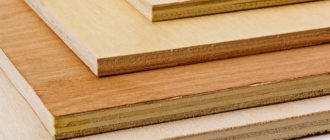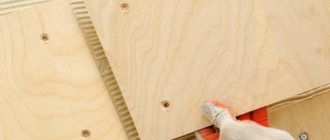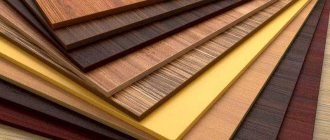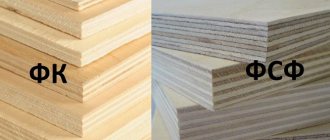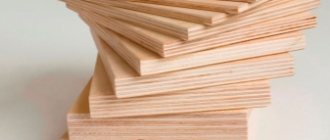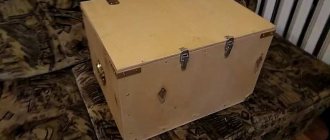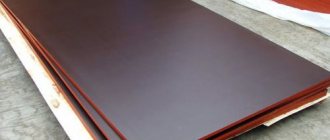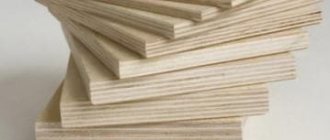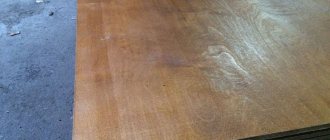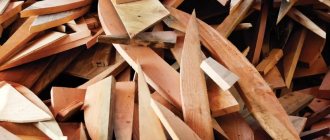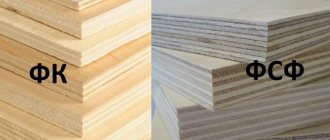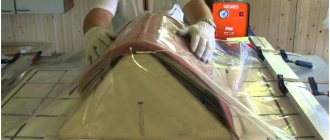Often, thin plywood is used not only for finishing work and aircraft modeling, but also for any other areas. For example, thicknesses of 5 mm and above, which, by the way, are also called “thin plywood” by many, are used for constructing subfloors under laminate, linoleum or parquet.
The range of uses of plywood as a material is very huge, but this does not mean that the product itself is monotonous. Whether a plywood sheet is suitable for a particular production or not depends on what grade it belongs to, and on what characteristics of strength, moisture resistance and elasticity are present in it.
Application area
The easiest and cheapest way to fasten plywood when making a subfloor is with self-tapping screws onto joists.
Laying this sheet material directly onto the screed is a more labor-intensive process. In addition, the budget for repairs/decoration of the premises increases. It is impossible to install insulation between the concrete base and plywood. Therefore, thermal insulation should already be included in the screed at the preliminary stage. Under the floor covering, you can only use film heated floors. All these disadvantages of the technology are compensated for in the following cases:
- it is impossible to use logs, as the level of finishing cladding in one room will rise, creating an inconvenient step;
- the insulation is already laid inside the screed or thermal insulation of the subfloor is not required;
- floor coverings with a coefficient of thermal expansion significantly different from the illogical characteristic of a concrete screed will be used in the room.
Therefore, PVC linoleum, synthetic carpet, parquet boards and natural parquet, laminate, manufacturers of these finishing materials always recommend laying them on plywood.
Some information about plywood
Plywood is included in the list of the most durable, best-suited building materials for eliminating unevenness in rough foundations. She is preferred for her harmlessness. Plywood does not contain very harmful volatile carcinogens, which cannot be said about chipboard (for more details: “Chipboard or plywood for the floor - pros and cons of materials”).
Versatility and durability make this material an excellent solution for the following work:
- elimination of unevenness of the old floor laid on logs;
- use as a base for dry screed;
- creating a clean floor covering;
- use as thermal insulation for rough foundations.
This relatively lightweight and wear-resistant material does not place excessive load on the floors, which makes it possible to lay it on an old floor with joists. Very often, plywood is used in multi-story buildings, where there are weak floors between apartments (read: “How to make a plywood floor in an apartment”).
Features of furniture plywood
Laminated plywood for furniture making.
- For the manufacture of furniture, sheets are used with a thickness of 3 mm (low-grade three-layer plywood, which is most often used for the back walls of mirrors and drawer bottoms) to 30 mm (high-grade five-layer panels, which are used for desk tops).
- In the production of high-quality furniture, expensive decorative veneer is used as front layers.
- Since plywood furniture must not only be durable, but also have an attractive appearance, its production is carried out in special workshops where adhesive compositions and workpiece parts are carefully selected.
Advantages and disadvantages of plywood sheets compared to wood
The photo shows a TV stand made of plywood.
Materials such as furniture board or plywood are successfully used in furniture production, and today, much more often than natural wood. As mentioned above, the main reason for this is the low price of plywood sheets.
However, in practice this material has a significant number of advantages.
Let's look at some of them:
- It consists of wood, only from thin layers (about 1 mm), and its price is an order of magnitude cheaper.
- Even large plywood sheets are shaped stable. This is achieved due to a special production technology - crossing veneer fibers.
- True freedom of choice regarding sizes.
- High lateral strength when compared with a wooden panel of the same thickness.
Unfortunately, this material has in addition to its advantages.
It also has some disadvantages:
- The mass of a plywood sheet will be greater than that of a wooden sheet of similar thickness.
- The ends have stripes, which affects the aesthetic perception of the product, since many have a negative attitude towards plywood as a material.
Lining the ends of plywood.
This material gives you less freedom in surface treatment, since the front layers are about 1 mm thick, so they can be “removed” with a tool if you are careless. Some manufacturers save on adhesives by using adhesives that are harmful to human health
Thus, purchasing plywood from an irresponsible manufacturer can have unpleasant consequences, which cannot be the case with the purchase of natural wood, even of the lowest quality.
How to choose the right one
Plywood is more than just pressed sheets of wood veneer. Each type of product may have individual performance characteristics, which determine its scope of application. Naturally, even at the selection stage it is worth deciding on the purposes of using material of a certain standard. This will significantly reduce construction costs. For example, moisture-resistant plywood is somewhat more expensive than that which does not have this property. There is no point in using it unless absolutely necessary.
Areas of application for plywood of different thicknesses and sizes
The main parameter that affects the scope of application of pressed wood sheets of different sizes is thickness. The strength of the material depends on the number of layers.
| Thickness standard (in mm) | Running dimensions (standard, in mm) | Application area |
| 1-3 | 1525x1525 1525x1830 | The flexibility of the material allows it to be used for modeling - crafts, layouts, models. |
| 4 | 1252x1525 | Furniture production, wall and floor cladding. |
| 6-6.5 (5 layers of veneer) | 1525x1525 1220x2440 1500x3000 | Furniture production, finishing works. |
| 8-10 | 1525x1525 1220x2440 1500x3000 | Furniture production, finishing. The thickness of the material allows it to be used for finishing the floor in one layer. |
| 12-15 (slabs with 9 or more layers of veneer) | 1525x1525 1220x2440 1500x3000 | For the production of industrial furniture with increased load, in the construction of roofs. |
| 18-30 (peeled veneer) | 1500x3000 1525x2440 | For arranging formwork for strip bases, production of garden furniture, floors between floors, construction of light summer structures. |
| 35-40 | 1500 x 2440 1500x3000 1525x3000 | Construction of flights of stairs, flights, assembly of pallets, countertops, furniture panels, furniture. |
Moisture resistance
This is the ability of plywood not to deteriorate under the influence of variable humidity. The indicator directly depends on what timber and adhesive compositions were used in production. The necessary characteristics are given to plywood by synthetic resin, which reliably protects the veneer from moisture.
On the market you can find material with an average moisture resistance (FC) and ultra-resistant (FSF). Naturally, the cost of plywood directly depends on this important characteristic.
Layers
When producing material of different sizes, layers of veneer are laid on the central core - symmetrically on the sides. The core itself can be made of different materials - wood, veneer, etc.
Surface treatment
You can find two types of plywood on the market - SHF and NF. After all layers with glue are connected by hot pressing, some of the standard size sheets undergo additional processing - grinding. Moreover, either one side or both can be processed.
ShF has a smooth, light surface, a wider range of applications, and more stringent requirements for deviations from the norm in size and thickness. Accordingly, the cost of polished material is higher.
Sanding plywood
Stamps
FBA
This type of plywood is produced by gluing veneer with a special albumin-casein mixture. From an environmental point of view, FBA is an impeccable product, but it cannot be used everywhere. Maximum expansion of the use of such plywood is hampered by its insufficient resistance to moisture.
FSF
This brand means sizing with a phenol-formaldehyde-based resin composition. This treatment guarantees excellent performance properties. The material will be mechanically strong and practically does not wear out. Resistance to moisture is quite high. FSF is used in the construction industry, industry, and is often purchased for roofing work.
FC
This option involves joining the veneer using a urea compound. This technology is much better suited for various indoor spaces. Plywood with urea glue is very durable. The level of safety is sufficient for use in furniture, so it is also suitable for flooring.
FB
In this case, the veneer is saturated with bakelite-based varnish. This solution dramatically increases resistance to water ingress. The FB board can be safely used even in tropical and subtropical areas. The thickness of the workpiece is usually small, since insulation is not provided. FB is also suitable for floors in laboratories, kitchens, workshops and other places where exposure to aggressive substances is likely.
BS
In this case, treatment with a Bakelite-based composition is also used, but not with varnish, but with glue. This veneer is sometimes called aviation veneer, since it was previously used in the production of aircraft and river and sea vessels. This material is very durable and tolerates contact with moisture well. It does not grow harmful fungi.
BV
This brand of plywood is glued with a water-soluble bakelite solution. The slabs obtained in this way are not sufficiently resistant to water. But their strength is at a decent level. Bakelite plywood of any type must comply with GOST 11539-2014. There are no specific restrictions on size, so we need to cover this topic in more detail.
Plywood classes and their purpose
Based on the main characteristics, plywood is usually divided into classes according to its purpose:
1. Shipboard – birch plywood grade FB. Impregnated with glue under high pressure and temperature. Maximum moisture resistant. They are used not only in the production of watercraft, but also in places requiring high wear resistance: structures for ports, berths, etc.
2. Furniture – birch, impregnated with urea glue. Absolutely environmentally friendly, durable and with good strength characteristics. Often used in children's institutions, hospitals, etc.
3. Construction - light and durable plywood, suppresses noise well and retains heat. Quite cheap, used everywhere. The main disadvantage is that the appearance is not beautiful enough for exterior decoration.
4. Aviation – FSF brand plywood, impregnated with formaldehyde glue. Its strength is comparable to steel and has high resistance to mechanical stress. Used in the production of aircraft, carriages, cars, etc.
5. Formwork – laminated plywood. Meets the requirements of moisture resistance, does not swell or deform. After pouring the foundation it can be reused.
6. Decorative – FK grade plywood, made from the first grade of wood. The main difference is the pronounced decorative surface pattern. Often varnished or laminated. Used for fine finishing of premises and in the production of furniture and decor.
7. Automotive – laminated plywood of the FSF brand. Durable, lightweight and not deformable. It is used for covering floors, doors and, of course, in finishing car interiors and van bodies.
Selection of material
So that later the question does not arise as to why the laminate creaks, it is necessary to choose the right plywood for the base. Having decided on the general qualities of plywood, it is worth talking about its individual brands and determining which plywood to lay under the laminate.
There are a huge variety of plywood varieties, among which there are cheap and very expensive options, for example, the BS brand has a very high price and is used only in the construction of watercraft and air transport.
Plywood also differs in its strength, moisture resistance and toxicity, which does not allow the use of certain brands in enclosed spaces (read: “Which plywood is best for the floor - choosing the brand and type of material”).
Types of plywood used for laying indoor flooring:
- FSF brand plywood has a high moisture resistance, but is not recommended for use in residential premises due to the toxicity of the glue.
- FOF is a brand of plywood that is completely harmless, because toxin-free adhesives are used for its production, but here its disadvantage manifests itself - poor moisture resistance.
- The FC brand can withstand exposure to a small amount of water, but it is also not worth watering. Plywood is harmless and can be used to install the base under the laminate.
Speaking about what kind of plywood is needed for a laminate floor, it is also worth paying attention to the material from which the plywood is glued together:
- The coniferous base
is resistant to various influences, for example, fungus, but when interacting with glue, the resin can release toxins, so it is practically not used in residential premises. - Birch plywood
is the best solution for laying a base under a laminate, because it does not emit toxins and is quite durable, but it should be treated with special antiseptics against fungus and pests.
Having considered all the variations of plywood, it is worth noting that FK brand plywood made from birch is an ideal option for flooring under laminate, and for outdoor work it is better to use the FSF brand made from pine needles.
Having chosen a brand of plywood, you should choose the appropriate grade and coding. Varieties are divided according to the quality of the material:
- First-grade plywood does not have any flaws and can be used to level the floor, but it has a very high price.
- Second-grade plywood has minor imperfections, such as veneer inserts and knots. It is used for laying the base, but this is also not the cheapest option.
- Third-grade plywood is an ideal option for laying under laminated flooring. There are many knots and cracks on the surface of the plywood, but they will not interfere with the work. Plywood has an excellent combination of price and quality. It is better to make a choice so that the thickness of the plywood under the laminate is slightly greater than indicated below.
- The fourth grade of plywood is not suitable for installation work related to the floor, because it has strong unevenness, and its price is not much lower than the previous option.
The plywood price tag will also have a coding written on it, for example, FK-3E1SH1, which we need. It contains various information about the plywood sheet, which is not necessary to understand.
Content
- Design features
- Plywood varieties
- Types of moisture resistance
- Plywood thickness
- Thin plywood
- Medium plywood
- Thick plywood
The thickness of plywood depends on several parameters: the type of wood, the amount of veneer used. This indicator is important when carrying out construction and finishing work.
Advantages
Plywood is considered one of the most convenient and practical materials for leveling the floor.
It is known that plywood is a wood processing product, so it has the same basic properties as wooden products, while plywood has a number of advantages over wood due to its structure. For example, thinner than boards, sheets of this building material have the same resistance to mechanical loads as the latest ones. It turns out that a lighter plywood structure can be no less rigid and elastic than a wooden one. In addition, veneer material can provide an absolutely flat surface, which makes it one of the most successful choices when arranging durable ceilings, walls and floors; in addition, plywood can be used to create a reliable base for different types of roofing. However, the main task here is to determine which plywood is best suited for the floor.
It’s worth saying right away that plywood, although inferior (and not always) to some related products in a number of indicators, has one main advantage - high environmental friendliness. And its properties are directly related to the brand, manufacturing technology and grade. It should be noted that the domestic industry produces quite high-quality products that are noticeably superior to Chinese samples, whose manufacturers strive to use cheap binders and defective veneers in their production. It is often very difficult to determine whether the outer layers of products from China have been sanded.
What are the advantages of plywood
There are many building materials for arranging floor coverings, in particular, in addition to plywood, OSB, fibreboard, chipboard and other varieties are used.
However, plywood has a number of undeniable advantages:
- The cost of plywood is significantly lower than that of other building materials. The estimated cost of 10 mm canvas will be from 400 to 1000 rubles, which depends on the grade and type of impregnation.
- Environmentally friendly and safe for health. Materials containing formaldehyde are used to join veneer sheets. However, the concentration of these substances is several times less than, for example, in chipboard. In some cases, other binding components are used altogether.
- Plywood is highly durable and very durable. In this regard, it is the best option for laying a rough covering under laminate, carpet or linoleum (read: “What is the optimal thickness of plywood under laminate”).
- Moisture-resistant plywood produced by manufacturers can be laid in rooms with high levels of humidity, for example, in bathrooms, kitchens, cold corridors, and even baths.
- The large format of glued veneer sheets makes the process of laying and leveling the floor as fast and convenient as possible.
The only drawback of this material is its expansion under the influence of changes in air temperature and humidity, just like any tree.
In this regard, it is not recommended to pour a cement screed on top of the plywood or lay ceramic tiles (about
Factors influencing the choice of plywood
Before making a plywood floor in a wooden house, you need to decide on the type of material. What to take into account when choosing sheets:
- Type of base. For example, a concrete base has a high thermal conductivity; losses can be reduced by sheets of greater thickness (from 15 mm). But it is better to sheathe a subfloor made of plywood on joists with a material layer thickness of at least 12 mm.
- Type of room (area of application). For residential areas, professionals recommend choosing the FC grade; it is produced without volatile chemicals.
- Thickness. Installing a plywood floor on joists requires selection of parameters, since the service life of the subfloor depends on the thickness - the thicker the board, the less it will sag when walking. However, you should not bend it in the direction of increasing the size - this increases the mass of the flooring, which also negatively affects the design of the joists.
Taking into account all the factors, choosing plywood for a wooden floor is not difficult.
Sheet thickness
The size range of plywood is varied: length can reach 6 m, width 3 m, and thickness starts from 3 mm. For roughing and finishing work on horizontal bases, the following are used:
- 1525*1525 mm with a thickness of 15 mm - this is the most popular product for installing sheets on joists;
- 1210*2440 mm – used for leveling foundations in standard multi-storey buildings;
- 500*3000 mm – sheets for studio-type premises.
As for what thickness of plywood to use for floor joists, the type of prefabricated screed and load level are taken into account:
- Degree of load. The greater the load on the floor, the thicker the sheets. Residential premises allow a parameter of 10 mm with a lag pitch of 0.4 m, but for commercial and other premises it is better to take slabs of 22 mm thickness.
- Type of finishing. The final cladding materials also have their own weight, a static load that will put pressure on the logs. If it is a laminate, then there is no big threat of increasing the mass, which cannot be said about solid boards or tiles.
So, what thickness should the plywood for the floor along the joists be: at least 8-12 mm for installation in two layers, at least 10-22 mm for a single-layer layout.
Types of plywood
Depending on the scope of application, the material differs:
- building;
- furniture;
- structural;
- industrial;
- packaging
According to the classification, the material is distinguished:
- Scope of application. For arranging a prefabricated screed, structural and construction types are shown.
- Brand. Determined by the type of adhesive composition used. It differs like this:
- FSF – sheets with increased moisture resistance, can be used in rooms with normal and high humidity levels. Resin adhesive composition with the addition of phenol-formaldehyde components;
- FC is a product of medium moisture resistance, best used in dry rooms. The adhesive composition is urea-formaldehyde;
- FBA sheets practically do not tolerate moisture. Glue with albumin-casein components.
- Grade. It differs in the permissible number of wood defects and processing defects:
- E – extra class, made from oak, walnut and birch. Perfectly straight sheets without knots, chips and other defects;
- I – there are knots of light or dark shade, no more than 3-5 units/m2. There is no more marriage;
- II – knots (captive) with a diameter of no more than 6 mm in the amount of 6-8 units/m2 are visible, there may be cracks 0.2 cm long and up to 0.2 cm wide (fused or sealed);
- III – sheets with wormholes, knots up to 6 mm in the amount of 8-10 units/m2, cracks 0.3-0.6 cm long, 0.5 cm wide (closed), dents, scallops;
- IV – grade with defects, chips along the edge without restrictions.
- The nature of the processing differs in grinding: Ш1 – processing of one side, Ш2 – both sides are polished, НШ – no grinding. You can use any slabs for the floor along the joists, but it is better to use one-sided sanding to get a perfectly smooth base for finishing.
Having figured out what thickness of plywood for floor joists is better, you should determine other suitable sizes:
- FC brand;
- emission class E1;
- grade: for subfloor 3-4, for finishing 1-2;
- humidity 12-15%;
- number of layers (thickness) 8-12 mm.
Plywood classification
Plywood is divided depending on the appearance of the surface into grades, according to the degree of water resistance of the adhesive joint into grades, and according to the degree of surface treatment into sanded and unsanded. A comprehensive answer to the question of what kind of plywood is available can be obtained by studying the provisions of the current standards GOST 3916.1-96 and GOST 3916.2-96.
Materials are classified according to the above criteria as follows:
- In appearance, taking into account the outer layers of veneer. There are five grades: the highest of them is designated by the English letter E, the rest - by Latin numerals from I to IV.
- According to the level of moisture resistance of the binder composition. Plywood is divided into grades:
- FSF – increased degree of water resistance for outdoor and indoor use.
- FC – moisture resistant for interior work.
- By surface treatment method:
- NS – not polished.
- Ш1 and Ш2 – polished on one and both sides, respectively.
- Laminated.
The above classification does not take into account the type of wood from which the panels are made. What is modern plywood made of, and what raw materials are used for its production?
During the manufacture of the material, the following types of veneer are used:
- Deciduous: birch, beech, elm, maple, linden, aspen and poplar.
- Coniferous: spruce, cedar, larch, pine and fir.
Plywood made from one type of veneer is called homogeneous, while plywood made from different raw materials is called combined. In the latter case, the material is considered to be made from the type of wood that was used in the outer layers. Information about this is indicated in the labeling and helps to avoid confusion when selling products. If there is an even number of layers in the slab, then the middle two are made from veneer of the same species, and the direction of their fibers should be parallel.
Factors influencing the choice of plywood
Before making a plywood floor in a wooden house, you need to decide on the type of material. What to take into account when choosing sheets:
- Type of base. For example, a concrete base has a high thermal conductivity; losses can be reduced by sheets of greater thickness (from 15 mm). But it is better to sheathe a subfloor made of plywood on joists with a material layer thickness of at least 12 mm.
- Type of room (area of application). For residential areas, professionals recommend choosing the FC grade; it is produced without volatile chemicals.
- Thickness. Installing a plywood floor on joists requires selection of parameters, since the service life of the subfloor depends on the thickness - the thicker the board, the less it will sag when walking. However, you should not bend it in the direction of increasing the size - this increases the mass of the flooring, which also negatively affects the design of the joists.
Important! Professionals advise to be guided by the distance between the lags (step). If the cell size is 0.5-0.6 m, the sheet thickness must be at least 15 mm
Taking into account all the factors, choosing plywood for a wooden floor is not difficult.
Sheet thickness
The size range of plywood is varied: length can reach 6 m, width 3 m, and thickness starts from 3 mm. For roughing and finishing work on horizontal bases, the following are used:
- 1525*1525 mm with a thickness of 15 mm - this is the most popular product for installing sheets on joists;
- 1210*2440 mm – used for leveling foundations in standard multi-storey buildings;
- 500*3000 mm – sheets for studio-type premises.
As for what thickness of plywood to use for floor joists, the type of prefabricated screed and load level are taken into account:
- Degree of load. The greater the load on the floor, the thicker the sheets. Residential premises allow a parameter of 10 mm with a lag pitch of 0.4 m, but for commercial and other premises it is better to take slabs of 22 mm thickness.
- Type of finishing. The final cladding materials also have their own weight, a static load that will put pressure on the logs. If it is a laminate, then there is no big threat of increasing the mass, which cannot be said about solid boards or tiles.
Types of plywood
Depending on the scope of application, the material differs:
- building;
- furniture;
- structural;
- industrial;
- packaging
According to the classification, the material is distinguished:
- Scope of application. For arranging a prefabricated screed, structural and construction types are shown.
- Brand. Determined by the type of adhesive composition used. It differs like this:
- FSF – sheets with increased moisture resistance, can be used in rooms with normal and high humidity levels. Resin adhesive composition with the addition of phenol-formaldehyde components;
- FC is a product of medium moisture resistance, best used in dry rooms. The adhesive composition is urea-formaldehyde;
- FBA sheets practically do not tolerate moisture. Glue with albumin-casein components.
- Grade. It differs in the permissible number of wood defects and processing defects:
- E – extra class, made from oak, walnut and birch. Perfectly straight sheets without knots, chips and other defects;
- I – there are knots of light or dark shade, no more than 3-5 units/m2. There is no more marriage;
- II – knots (captive) with a diameter of no more than 6 mm in the amount of 6-8 units/m2 are visible, there may be cracks 0.2 cm long and up to 0.2 cm wide (fused or sealed);
- III – sheets with wormholes, knots up to 6 mm in the amount of 8-10 units/m2, cracks 0.3-0.6 cm long, 0.5 cm wide (closed), dents, scallops;
- IV – grade with defects, chips along the edge without restrictions.
Important! If you look at what kind of plywood to use for flooring based on inexpensive joists, then grades 1-4 will do. But double marking of sheets is possible: 1/3, 2/2 - this means that one side corresponds to a high grade, and the other to a low one
- The nature of the processing differs in grinding: Ш1 – processing of one side, Ш2 – both sides are polished, НШ – no grinding. You can use any slabs for the floor along the joists, but it is better to use one-sided sanding to get a perfectly smooth base for finishing.
Having figured out what thickness of plywood for floor joists is better, you should determine other suitable sizes:
- FC brand;
- emission class E1;
- grade: for subfloor 3-4, for finishing 1-2;
- humidity 12-15%;
- number of layers (thickness) 8-12 mm.
Advice! Please note that with a two-layer flooring, the thickness of the overall structure is divided by 2. However, the choice of price matters here: sheets of plywood 15 mm thick are not much more expensive than a sheet of 30 mm, but laying and transporting lighter material is more convenient
What is the thickness of plywood?
How to choose the right plywood and what thickness it comes in
- Design
- Classification
- Sheet thickness
- Plywood selection
The name of this building material is of foreign origin, taking its roots from several European languages. Most philologists are of the opinion that the term "plywood" is derived from the French word fournir, meaning "to supply" or "to lay on." Gradually it underwent changes in the German and Dutch languages, spreading throughout the globe in a sound specific to each nation. In the Russian version, “plywood” has become a familiar name for the well-known multilayer sheet made from wood raw materials, characterized by an affordable price and good functional characteristics. Its use is not limited to repair and construction work. The furniture industry cannot do without this woodworking product; it serves as a finishing material for the interiors and bodies of aircraft, cars, ships and railway cars.
The combination of the number of layers and the thickness of plywood.
Design
Plywood board is sheets of wood veneer glued together into a monolithic whole using special equipment using formaldehyde resins. For the outer layer the thickness should not be higher than 3.5 mm, and in the inner layers it should not exceed 4 mm. Plywood can be assembled using various technologies, using veneer from one type of wood or from several types of wood. According to these indicators, it is divided into homogeneous and combined, which may include various types of deciduous or coniferous cuts. The arrangement of fibers in sheets can be parallel or mutually perpendicular, and also differ in symmetry.
Return to contents
Classification
Plywood is divided into types according to several indicators, on which its performance characteristics, appearance and cost depend:
- type of wood;
- surface type;
- type of gluing;
- degree of machining;
- moisture resistance;
- formaldehyde content.
These important parameters must be taken into account when choosing a material for repair or furniture manufacturing, but the strength and durability of future structures and products will largely depend on how thick the slabs will be.
Return to contents
Sheet thickness
What thickness and size the sheets of this material will be are determined by the type and grade of raw materials, manufacturing and processing technology, as well as the purpose of further use in everyday life or production.
There are several types of these products with different thickness parameters.
The most popular among consumers is coniferous plywood, which is an indispensable means for constructing a base for floor coverings and is widely used in the manufacture of furniture and in repair and construction work. With a slab size of 1220×2440 and 1225×2500 mm, there is plywood with the following thickness in millimeters:
Selection of veneer for plywood grades.
The cached type of plywood boards is made using a double-sided paper coating impregnated with a special type of synthetic resin. This treatment makes it possible to use plywood outdoors, and it is well suited for painting. A standard size sheet of 1220x2440 mm can have a thickness of 6, 8, 10, as well as 12, 16 and 19 mm. Most often, cabinet furniture and formwork are made from it.
The presence of veneer made from valuable wood species on the surface distinguishes decorative plywood, which is indispensable for aesthetic finishing in interior design and furniture manufacturing. It comes in the following thicknesses: 3, 6, 10, 12, 16 and 19 mm. For the same purposes, there is a type of this material made of birch veneer, which holds all types of fasteners well. Square sheets 1525x1525 mm have thickness options of 4, 6, 9, 12, 15 and 18 mm. Birch plywood is of the American variety Appleply, which has a minimum size of 6 and a maximum of 25 and 32 mm. Its disadvantage is its rather high price.
Flexible plywood has the smallest variety in layer size variations. The slab, assembled from perpendicular wood slices, has a thickness of 3 or 10 mm and a size of 1220 × 2440 mm.
Return to contents
Plywood selection
Each package of plywood sheets is marked indicating the quality of the material. Usually there are 5 grades: from the elite, with the complete absence of any defects, to the last, which has an unlimited number of knots and wormholes. The dimensions of the sheet and its thickness in millimeters are also shown here. The marking contains the necessary information about the composition of the wood, the type of sanding and the emission class of formaldehyde contained in the material.
The use of plywood to level and strengthen the floor depends on the expected strength and height of the base. Typically, sheets from 8 to 12 mm are used for this purpose, which are attached to the installed joists using self-tapping screws. It is not profitable to buy thicker material for these purposes, but when making a decision, it is necessary to take into account the physical loads that the surface of the material will experience during operation. In the manufacture of cabinet furniture, the thickness of the plywood sheet will depend on its location. Most often this figure is in the range of 4-8 mm. Work on cladding walls and ceilings is usually carried out with plywood from 9 to 12 mm.
How thick is plywood, its types and features
Plywood is a universal building material from which a large number of different products are made. How thick is plywood for use in different types of work?
Plywood fragments are essentially compressed sheets of wood. Taking into account the glued layers, they are divided into three, five and multi-layer.
Plywood sheets with many layers
Note!
Cedar is used more often for production; deciduous trees are used much less often due to their high cost.
Due to different levels of moisture resistance, the following types are distinguished:
- FC - sheets with layers that are connected with urea glue. Its moisture resistance is relatively low. They are used more often for finishing rooms or for industrial furniture.
The thickness can be 3, 10; 12; 15; 18 and 21 mm. The density of the sheets is, respectively, 640 - 700 kg per cubic meter.
- FSF - made using phenolic resin. It is considered one of the most popular in construction. It has a high level of moisture resistance, strength and wear resistance. Used for interior decoration and roofing work. The nominal humidity indicator cannot exceed 10%.
Thickness can be 6; 9; 12; 15; 18; 21; 24; 27; thirty; 35; 40 mm. The density of the sheets is, respectively, 640 – 700 kg per cubic meter.
- FB, BS, FBS - produced by gluing veneer using varnish or bakelite glue. Used in aviation structures and in the shipbuilding industry. They have increased strength and water resistance, which allows them to be used in difficult conditions. The maximum nominal humidity is 10%.
The thickness is 0.5; 0.7; 1; 1.2; 1.4; 1.6; 1.8 cm. Density - about 1200 kg per cubic meter.
- BV - impregnation contains a special water-soluble glue - bakelite. Indicators and characteristics are generally identical to the previous type.
- FOF - called a laminated type of material. The upper part is distinguished by a facing film coating, impregnation of the tiles using synthetic resin.
Thickness 0.4; 0.65; 0.9; 1.2; 1.5; 1.8; 2.1; 2.4; 2.7; 3; 3.5 and 4 cm. The density of the sheets is, respectively, 640 - 700 kg per cubic meter.
According to the quality level, the following types are distinguished:
- The minimum number of errors is external;
- The presence of small veneer inserts or knots;
- There are defects, cracks, knots;
- Low level when gluing.
Thin sheets of material
The following main types of plywood are distinguished:
- E – elite. It has few shortcomings and flaws, minimal deviations in structure are possible. To completely hide defects, there is a good method of varnishing.
- I – high quality. Cracks and defects no larger than 20 mm in size are acceptable. Suitable for exterior decoration.
- II – quality is at the proper level. Can be coated with different paints during finishing work. Defects can occur up to 200 mm, and there are also small leaks of glue.
- III – average level of quality. Can be used for arranging internal and hidden types of structures. The presence of a significant number of cracks and knots is allowed.
- VI – low level. Any shortcomings can be found here. It is used in any field - for roofing, flooring, wall installation, various packaging.
Types of plywood sheets
Of course, for each type the price will be appropriate.
Choosing the optimal plywood thickness
What is plywood? Where and how is it used? What types are there? What is its thickness? You will find answers to all these questions in this article. Wood-laminated board, chipboard or plywood are multilayer materials used in construction. It is made by gluing veneer. What is this? - an inexperienced user will ask. Let's explain: these are thin sheets of wood. Thickness, which ranges from 0.5 mm to 3 mm.
Plywood, it's so different
Chipboard is an almost universal material. It is even used in shipbuilding and automotive manufacturing. It is used to create formwork, sound insulation, window sills and doors. A wide variety of furniture: tables, cabinets, kitchens.
When purchasing plywood for any purpose, pay special attention to its thickness. If we talk about factory production, then there are models from 3 mm to 40 mm. Of course, if your budget allows and you have special requirements, you can order sheets with individual characteristics.
Then the thickness of the plywood will depend only on your wishes. But remember, if you lack knowledge, it is better to contact a sales specialist. Properly selected plywood thickness is the key to long service life.
Varieties
As you already understood, plywood is sheets of wood glued together. Depending on the number of layers, it is divided into:
There are thousands of species and varieties of trees in the world. Sometimes cedar is used for high-quality decorative plywood. It should be noted that hardwoods are used less frequently as a starting material. This is due to the high cost of production.
Coniferous or deciduous
Birch material will, of course, be more expensive. Then why? Such plates are used where special characteristics are needed. Combining the physical and mechanical characteristics of this wood and the layering of the material, we obtain a high-strength material. This quality is especially valued in the automotive industry, carriage building, and in those industries where strength plays a decisive role.
Birch chipboard is distinguished by its delicate color and unusual wood structure. Thanks to this, furniture manufacturers and designers fell in love with it. The latter use it in the interior and exterior.
The softwood slab is distinguished by its weight. It's lighter. In most cases, such plywood is made from pine. Firstly, it has an attractive appearance. Secondly, despite its low weight, it differs in strength indicators.
It is widely used in the construction of houses. The walls are sheathed, the roof is covered, the floor is laid. construct interior partitions. The needles are quite resistant to fungal infection and rotting. All this because the tree is impregnated with resins.
Plus, the sheets are connected with phenol-formaldehyde glue. This plywood is used in the manufacture of furniture, design inside and outside the house.
During operation, chipboard made from pine needles changes its dimensions: 0.03% - thickness and 0.02% - width and length.
Combined plywood consists of alternating layers. One by one, thin layers of coniferous and deciduous species are connected. What's good about this material? It is strong and not expensive. What makes it stand out? At the same time, he does not lose external indicators. This plywood is attractive and is also often used in furniture making, decoration and construction.
What is she like?
Depending on moisture resistance, there are several types of plywood. A person unfamiliar with them may become confused when he notices strange markings in a store. Let's look at each in more detail. What are the characteristics and thickness of each of them?
FC is plywood, the layers of which are connected with urea glue. The moisture resistance indicators of this species are quite low. Therefore, this type is used only for interior decoration or in furniture production.
Based on quality, 4 types can be distinguished:
- minimal external flaws;
- small inserts of knots and veneer;
- a large number of defects, cracks and knots;
- the lowest grade, which at the same time has high gluing strength.
Thickness: 3-10, 12, 15, 18, 21 mm. Density: 640 - 700 kg/m3.
FSF - phenolic resins are used in the production process of this type. This is one of the most popular materials in the construction industry. Firstly, this plywood is quite moisture resistant. Secondly, it has high strength and wear resistance.
FSF can be used for interior decoration. For external work, such as roofing.
Nominal humidity does not exceed 10%. Thickness: 6, 9, 12, 15, 18, 21, 24, 27, 30, 35, 40 mm. Density: 640 - 700 kg/m3.
FB, BS, FBS - this type of chipboard is produced by gluing veneer with bakelite glue or varnish. Such plates are used in aviation and shipbuilding. They have the highest levels of strength and water resistance. This makes it possible to use this type in the most extreme conditions, with high humidity and high pressure.
It doesn’t matter what material was used in manufacturing, the nominal humidity remains the same as in the previous case - no more than 10%.
Thickness: 5, 7, 10, 12, 14, 16, 18 mm. Density: 1200 kg/m3.
BV – plywood impregnated with special water-soluble glue. It's called bakelite. This type has retained all the characteristics and indicators of the previous one. The only thing that distinguishes it is the glue, which, as we see from the name, dissolves under the influence of water.
FOF is a laminated type of plywood. On top it has a facing film coating. The plate is impregnated with synthetic resin.
Thickness: 4, 6.5, 9, 12, 15, 18, 21, 24, 27, 30, 35, 40 mm. Density: 640 - 700 kg/m3.
Of course, plywood is not wine, but it also has its own varieties. They depend on what the outer layers look like.
Every plywood has its own grade
There are 5 varieties:
1. E – elite. He has few flaws. Allows minimal deviations in the wood structure. The only thing that may be present is the eyes.
- partially fused or unfused, falling out knots;
- holes from them;
- brown veins;
- wormholes.
2. I – high quality plywood, which is almost ideal. A crack or defect is allowed, the size of which does not exceed 2 cm. This grade is suitable for external decoration.
3. II – the slabs are of good quality. They can be coated with various paints and finishing materials. There are flaws up to 20 cm, slight leakage of glue.
4. III – average quality of plywood. It is used to construct internal structures that are not visible to the eye. For this grade, a significant number of cracks, wormholes and knots are allowed.
5. VI – lowest quality. By choosing this variety, you will receive material with any shortcomings. But it has a wide range of applications: roofing, flooring, wall installation, various high-strength packaging. Don't forget about the low price.
During the renovation, you decided to level and insulate the floor using chipboard. Let's find out how thick the plywood for the floor is. By analyzing all the information presented above, we can come to the following conclusion. The best option is birch plywood type FK. The optimal thickness recommended by repair experts is 12 or 16 mm.
If we add details, then the thickness of plywood for linoleum is at least 6 mm. This size is needed so that the caps of the fastening elements are completely recessed into the coating. But the thickness of the plywood under the laminate largely depends on the foundation. If it is smooth and durable, a slab with a thickness of 8-10 mm is sufficient. Otherwise, it is better to use a material of at least 12 mm.
FC can also be the basis for parquet flooring. There is, of course, the use of FSF for these purposes. However, be careful. This type of plywood emits phenol fumes. This may affect the health of residents. It is for these reasons that it is not recommended to use this type of material in residential premises.
To lay plywood, sheets are cut into squares. After this, they are laid out on the floor. The seams between the parts are 8-10 mm. The distance from plywood to walls is 15-20 mm. Remember that under no circumstances should the sheets touch them.
Another question that may arise when choosing plywood is what sizes are there? By studying the table below you will get your answer.
- Main types of plywood Plywood is a very popular material for renovation, which is distinguished by its quality, ease of use and excellent…
- Application of MDF and waterproof plywood In construction, repair, furniture production, various board sheet materials can be used, including chipboard,…
- DIY plywood arch A plywood arch is one of its simplest options. To make it you will need…
- Apollo - high-quality Chinese sanitary ware The company began its activities back in 1982, but it was the production of shower cabins and…
What are the methods for laying parquet boards and block parquet on plywood?
- The floating method involves the following laying technology: parquet blocks are simply laid on plywood. Since the joints and grooves of the segments coincide, the parquet will not “move apart” and bubble. Such parquet is easy to disassemble and reassemble if necessary, and replace a couple of boards in case of breakage. But! This method is quite suitable for parquet boards, but in the case of block parquet it is better not to use it: such dies are too small to stay level and firmly only due to mechanical adhesion. Block parquet requires glue.
- The glue method is as follows: first, sheets of plywood are laid with a small gap from each other, then attached to the base with dowels and screws. Then a special parquet adhesive is applied to the plywood. They let him dry. Parquet is laid on top of the glue. It is also necessary to coat the grooves and joints with glue.
The adhesive method is much more reliable than the floating method; it provides stronger adhesion of the parquet to the plywood, which means the floor is more even and does not creak or bubble.
So, is it possible to lay parquet flooring without plywood? It is possible, but only if you are dealing with a perfectly flat, sound-insulated base. Otherwise, this may affect the quality of the coating and will lead to the fact that, in the worst case, you will be forced to re-lay the parquet. So if it is possible to lay plywood under the parquet, then it is better to do so. Yes, this will require additional costs for the plywood itself, and for glue, and for the work of craftsmen (or it will take more of your time if you do everything yourself). But this will save you from the need for alterations and allow you to enjoy a smooth, warm parquet floor. We recommend reading the article on how to lay parquet yourself.
Moisture-resistant plywood
Moisture-resistant plywood based on hardwood veneer based on an adhesive made from urea-formaldehyde resins is absolutely safe for humans.
Of course, its wear-resistant and moisture-resistant characteristics make its use justified primarily in residential areas. The advantages of the material also include decorativeness, flexibility, sound insulation and affordable price.
The use of moisture-resistant plywood is not limited to construction and automobile production - it is also used to make furniture, packaging elements and even parts of speaker speakers.
Varieties and labeling
There are five grades of plywood. The highest is E (Elite), and then, as it gets worse, from I to IV. The grade is determined by the condition of the upper - front layers. Moreover, the quality of both surfaces is assessed separately and written through a slash. For example, I/II or III/IV.
GOST describes in detail what surface errors are permissible for which grade; there are special tables by which this grade is determined. If at least one parameter is worse than acceptable, the grade is reduced.
Varieties differ in the presence and size of certain defects
Here are the features on the front surface that different types of plywood may have.
- Elite For this brand of plywood, the veneer must be perfect. There may only be minor changes to the wood (no eyes). All. There should be no other shortcomings.
- I grade. There may be knots: pin knots, no more than 3 pieces per square meter;
- healthy, fused, dark and light with a diameter of 15 mm, no more than 10 pieces/m², they may have cracks no more than 0.5 mm wide;
- partially fused, not fused, falling out with a diameter of no more than 6 mm in an amount of no more than 3 pcs/m²;
- Knots: pin knots without restrictions;
- Knots: pin knots without restrictions;
- length no more than 300 mm no more than 2 pieces,
- Knots: pin knots;
- length no more than 300 mm without restrictions;
Correspondence of plywood grade designations according to various standards: GOST 3916.1-96, TU 5512-002-00255214-2000, GOST 10.55-71
If there are defects not listed in GOST, the product is considered substandard. It is also considered substandard if the maximum permissible size of defects is exceeded. Sometimes they try to sell such products as a fourth grade, but this is a re-grade and the price for it should be significantly lower.
By the way, if there are no obvious cracks or fallen knots, the third grade can be used for interior finishing. In certain interiors it looks even more interesting than E or the first, which are simply a flat sheet without any features inherent in wood.
The thinnest types of moisture-resistant material
Any moisture-resistant aircraft plywood from 1 to 3 mm is made exclusively from peeled birch veneer. It is also important that, according to technology, no connections are allowed in production.
The finished product may contain certain defects that are predetermined in the grade of material:
- Grade 1 allows for the presence of small (up to 3 mm) knots in the product, and minimal errors in thickness;
- the second grade also allows for errors and knots, but in a more immodest form, for example, from one knot to another there should be at least 20 cm and their diameter should not exceed 10 mm.
- in the third grade, the total number of knots should not exceed 7-8 pieces per square meter.
A product made of thin plywood in the 1-2-3 mm FC category has characteristic distinctive features, which are:
- Completely odorless.
- In a homogeneous surface.
- In excellent machine and hand processing.
- Also, all three types of moisture-resistant plywood sheets have increased strength characteristics and bending properties.
The standard ply thickness of FK grade plywood sheets is: 1 mm – 3 layers, 2 mm – 4 layers and 3–5 layers of veneer. Sometimes the manufacturer can change the technology and add 1 layer, or vice versa, remove it.
It should also be noted separately another brand of product - BPS - 1B. This 2 mm material is made of 5 layers of veneer. The main difference from the previous ones is that the middle of the sheet is made of 3 mutually perpendicular veneers. It is customary to line both outer sides with veneer sheets in such a way that their fibers are positioned strictly parallel to each other. In this case, the higher the grade of the product, the stronger it is.
Other types of plywood products
Plywood for automobile, railcar and container construction (TU 13-832-85) is produced in the following grades:
Plywood can be made of birch or coniferous veneer, with phenolic binders, with a density of no more than 900 kg/m3, with a format of 2440x1525 mm.
Thermosetting plywood has a middle layer of electrically conductive material that can be heated to 60 - 80 0C. FTO-V brand plywood is produced with a waterproof outer layer coating based on SBS-1 resin, FTO-L brand plywood is lined with paper film impregnated with phenol-formaldehyde resin. FTO-B plywood is produced using bakelized plywood technology, and FTO-P grade is produced using wood-laminated plastic technology. The thickness of thermosetting plywood is 10 - 12 mm. The electrically conductive material is carbon fiber paper with a resistance of 45-90 Ohms. Supply voltage - 50-60 V, specific power 400 - 500 W/m2.
Composite plywood is a composition of two or three different wood materials. It is possible to have plywood with a core of strips obtained by format cutting of finished products, intermediate and outer layers of commercial veneer. The bending strength of such products is at least 30 MPa. A composition of peeled veneer with thin (3 - 10 mm) particle boards is possible. To obtain a strength of at least 50% of the strength of traditional plywood, the proportion of outer layers (veneer) must be at least 1/3 of the thickness of the finished product.
Fire-resistant waterproof plywood is produced for the construction of passenger railway cars, including subway cars, where the problem of fire safety is very acute. Plywood is produced in thicknesses of 15 and 19 mm from deciduous and softwood veneer, impregnated with a fire retardant - a solution of liquid fuels according to TU 6-47-02-88. The impregnated and dried veneer is glued together with phenol-formaldehyde resin SFZh-3014. Otherwise, this plywood is close in its performance to plywood boards of the PF-A brand. Plywood is a low-flammability material with a flame spread index of no more than 20 (GOST 12.1.044-89).
Veneer boards are a material made from layers of peeled veneer, usually 3-4 mm thick, glued along the grain into products of almost any size. They are used as a building material for load-bearing and enclosing structures. Compared to conventional lumber, veneer boards have increased strength, elasticity and dimensional stability.
Comparison of lumber and veneer boards (LVL beams) performance
| Index | Veneer boards | Glued laminated timber, grade L40 | Structural lumber, grade T30 |
| Allowable bending stress, N/mm2 | 16 | 14 | 11 |
| Allowable shear stress, N/mm2 | 1,7 | 1,2 | 1,2 |
| Modulus of elasticity in bending, N/mm2 | 10 700 | 8 400 | 7 000 |
For plywood enterprises, the production of veneer boards is of interest as an opportunity to more fully use low-grade and piece veneer, producing new products from the same raw material base.
In Finland, the first industrial line with a capacity of 20 thousand m3 was launched in 1975, and since 1984 the equipment has been sold in the USA. The boards are made from 3 mm thick veneer, the thickness of the finished product is from 19 to 90 mm, which allows it to be used as beams, panels, beams in construction. The width of the material is 200-600 mm, length 18-23 m and is limited by the capabilities of vehicles. The new material is similar to thick plywood with the difference that the veneer fibers are located only in one (longitudinal) direction. Phenol and melamine-formaldehyde adhesives are used, raw materials are spruce, pine, birch. The length of the churaks is 1.3-1.9 m, the consumption of raw materials is approximately 3 m3/m3.
The production volume of veneered beams in Finland is about 30 thousand m3 per year. In Australia, the veneer board type material is called Hyspan. They produce boards with a thickness of 36, 45, 63 mm and a width of 150, 200, 240, 300, 360 and 400 mm. The length under transportation conditions does not exceed 12 m. It is noted that Hyspan appeared on the market in 1986 and in residential construction (in overhead coverings, when installing floors, as racks, spacers, lintels, etc.) is more economical than lumber.
Plywood: weight and thickness
The weight of a sheet of plywood directly depends on such an indicator as its thickness. The latter depends on the number of layers of veneer that were glued together under pressure in production.
Interesting: the thinnest plywood standard is 3 mm. Three layers of wood veneer are used for its production. But it's not the subtlest kind. You can find aircraft plywood in the store. This is a flexible wooden sheet less than 3 mm thick. It is used for modeling and various types of needlework. The peculiarity of the material is that when gluing, the veneer layers are arranged in such a way that the wood fibers have the same direction. This explains the extraordinary flexibility of the sheet.
Plywood 1525x1525
One of the most commonly used standards. The square sheet is classified as small format. It is convenient to work with him alone.
| Thickness (in mm) | Weight (in kg) | Number of sheets per cubic meter m |
| 3 | 4,5 | 143 |
| 4 | 6 | 107,5 |
| 5 | 7,7 | 86 |
| 6 | 9,2 | 71,7 |
| 8 | 12,4 | 54 |
| 9 | 13,8 | 45 |
| 10 | 15,3 | 47,8 |
| 12 | 18,4 | 43 |
| 15 | 23 | 35,8 |
| 18 | 26,8 | 28,7 |
| 20 | 30,8 | 23,9 |
| 21 | 32,2 | 21,5 |
| 24 | 36,9 | 17,9 |
Plywood 2440x1220
| Thickness (in mm) | Weight (in kg) | Quantity per cubic meter m |
| 3 | 5,8 | 112 |
| 4 | 7,7 | 84 |
| 5 | 9,7 | 67,2 |
| 6 | 11,6 | 56 |
| 8 | 15,5 | 42 |
| 9 | 17,4 | 37,3 |
| 10 | 19,4 | 33,6 |
| 12 | 23,2 | 28 |
| 15 | 29 | 22,4 |
| 18 | 34,8 | 18,7 |
| 20 | 38,7 | 16,8 |
| 21 | 40,6 | 16 |
| 24 | 46,4 | 14 |
Plywood 1525x3050
| Thickness (in mm) | Sheet weight (in kg) | Number of pieces per cubic meter m |
| 3 | 9,8 | 71,67 |
| 4 | 13 | 53,75 |
| 5 | 15 | 43 |
| 6 | 19,5 | 35,8 |
| 8 | 26 | 23,8 |
| 9 | 29,3 | 21,5 |
| 10 | 32,6 | 22 |
| 12 | 39,1 | 17,9 |
| 15 | 48,8 | 14,3 |
| 18 | 58,6 | 11,9 |
| 20 | 65,3 | 10,75 |
| 21 | 68,4 | 10,24 |
| 24 | 78,1 | 8,96 |
Reference: the indicated indicators are valid for plywood without additional treatments, lumber - birch. If coniferous species are used, the weight of one sheet is reduced. Additional processing, as a rule, increases the weight of a standard size sheet. for example, for the bakelite type - 24 mm, size 1525x3050 - instead of 78 kg it will be 134.
Material selection
Some sizes of large-format plywood sheets.
When choosing plywood for the floor, you should follow the manufacturer's recommendations for the areas of its application. When buying plywood, in order not to make a mistake and avoid unnecessary waste of money, ask the seller about its characteristics:
- brand, since the corresponding marking indicates the level of water resistance of the product;
- type of wood to know whether this plywood can be used for floor installation;
- thickness and design of sheets;
- grade, since the quality of the material and the condition of the surface depend on it;
- availability of lined materials on sale, which are best used when creating finishing coatings;
- environmental safety class of plywood;
- sheet sizes to ensure the most economical use of building materials.
As a rule, the standard dimensions of plywood sheets in length and width are:
- 1.22-1.22 m;
- 1.27x1.27 m;
- 1.475x1.475 m;
- 1.525x1.22 m;
- 1.525x1.27 m;
- 1.525x1350 m;
- 1.525x1.475 m;
- 1.525x1.525 m.
There are also larger sizes of plywood. These sheets are called large format sheets, but they can only be obtained by pre-order. In any case, plywood must be selected in accordance with the size and pitch of the joist. The thickness of the laminated veneer sheets is also related to the dimensions of the support beams and the distance between them. Manufacturers produce plywood with a thickness of 3 to 30 mm. Material from 3 to 12 mm is classified as thin plywood, building material with greater thickness belongs to the class of thick plywood. For floor installation, sheets of 10 to 15 mm thickness are used. For example, parquet up to 16 mm is laid on a 10 mm base, and from 16 to 20 - on a 12 mm base. For thicker parquet, 15 mm thick plywood is used.
Required tools and materials
To install plywood sheets on a wooden base, you may need the following tools:
- screwdriver;
- drill;
- hammer;
- screwdriver;
- level;
- electric jigsaw.
The materials used are self-tapping screws usually 30-50 mm long, nails or glue. The first ones are preferable to use, since they are the easiest to work with.
Self-tapping screws for wood
Differences by brand
FK grade plywood is used for the manufacture of containers and packaging, as well as in construction and furniture production.
Now, more about the brands of plywood sheets. They divide products according to the degree of their resistance to moisture.
- Bakelized (bakelite) plywood (FB brand) has high performance. It is often called Finnish. It is impregnated with bakelite varnish and can be used in any climatic conditions, aggressive environments and sea water. It is preferred by builders of small ships. The unique properties of FB are evidenced by its use in the construction of formwork for pouring concrete. Floors made from this plywood have an almost unlimited service life, but its price is significantly higher than the cost of products from other brands.
- BS is plywood, which is called aviation plywood. The veneer is impregnated with alcohol-soluble bakelite glue. The qualities of this plywood exceed those of BC, which is why it was widely used in shipbuilding and aircraft construction. It is distinguished by increased flexibility, strength, water resistance and resistance to fungi.
- BV grade plywood is also glued with bakelite compounds, but they are soluble in water. Sheets of this brand have high strength characteristics, but are not able to withstand dampness.
- FC – sheets, for gluing which urea adhesives are used. This plywood is familiar to almost everyone. Its moisture resistance characteristics leave much to be desired, but the building material is one of the most environmentally friendly. The resistance of FC to moisture can be improved by treating plywood with various impregnations.
- FBA - veneer is glued with albumin-casein adhesives. This brand is also afraid of moisture, but plywood is an environmentally friendly product from which products can be made for storing food products.
- FSF - waterproof plywood is made using phenol-formaldehyde resins. FSF is needed for flooring only on some external area, since this brand has a high level of formaldehyde release into the atmosphere.
Types of plywood
The finishing and construction materials market offers an extensive range of multilayer slabs. Deciduous and coniferous plywood, the types and varieties of which are described in this section, differ in the degree of processing of external surfaces, the composition of adhesives and impregnation. Bakelized and laminated panels, which have excellent physical and mechanical properties and decorative qualities, are also distinguished as separate types.
According to the composition of the glue and type of impregnation
The water resistance of plywood of the first and all other grades is determined by the properties of the binders used in its manufacture.
In the production of panel materials, the following types of adhesives and impregnations are used to improve their basic characteristics and performance qualities:
- Phenol-formaldehyde glue (PSF). Plywood has maximum moisture and wear resistance; only sheets with an emission class no higher than E1 are suitable for interior decoration and furniture production.
- Fireproof (FSF-TV). It belongs to the category of low-flammability due to impregnation with pyrophores; it is used in the construction of passenger cars and in construction.
- Melamine-formaldehyde and melamine resins (FKM). Average level of moisture resistance, intended for external and internal use.
- Urea glue (FC). Moisture resistance indicators are below average, the main area of application is interior cladding.
- Albumincasein glue (FBA). Environmentally friendly material due to the use of natural-based compounds with extremely low resistance to moisture.
The most common types of plywood FSF and FK have significant differences in their class of water resistance and environmental friendliness. Correct selection of slab materials is possible only taking into account their fire resistance, which is significantly improved through the use of special impregnations.
According to the degree of surface treatment
The outer layers of grade 3 plywood veneer, like other categories, can be sanded on special machines. The level of surface treatment is determined based on roughness indicators in accordance with GOST 7016.
This parameter has the following meanings:
- No more than 100 microns for polished;
- Up to 200 microns for unpolished.
Plywood sheets, depending on the quality of mechanical surface treatment, are divided into three categories: unsanded and sanded on one and both sides. This is taken into account when choosing and using the material.
Bakelized plywood
Various compositions are used to impregnate slab multilayer materials, which significantly improve their characteristics.
Higher grades of plywood 2, 1 and E are treated with bakelite adhesives or varnishes and are divided into the following types:
- FB. Before gluing, the layers of peeled veneer are additionally soaked in glue.
- BS – aviation plywood. An alcohol solution of glue is used to impregnate it, which gives the material the highest level of strength and resistance to aggressive environments.
- BV is a slab material impregnated with water-soluble glue.
Any bakelite multilayer plywood (with the exception of BV) has good resistance to moisture and high temperatures, which makes it possible to use them in the tropics. The slab material BS is intended for the construction of river and sea vessels, as well as for the manufacture of small aircraft.
Laminated plywood
The durability of glued multilayer slabs is increased by lining their outer surfaces with special materials. Laminated plywood is manufactured according to the technical conditions provided for by GOST R 53920-2010. A special film is applied to both sides of the sheet, resulting from the impregnation of the paper with thermosetting polymers.
Depending on the type of coating, there are five grades of slab material:
- FOB - F/F. Smooth on both sides.
- FOB - F/W. Smooth on one side and mesh on the other.
- FOB - SP/SP. Paintable film on both surfaces.
- FOB - F/SP. Smooth on one side, paintable on the other.
- FOB - F/U. Lined only on the front side.
High-quality birch plywood, which has high moisture resistance and has an emission class of no more than E1, is used as the basis for the laminated one.
